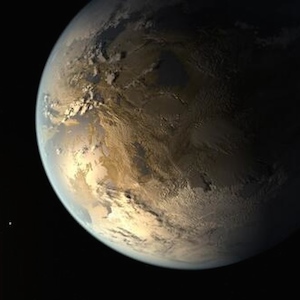NASA Has Discovered Earth's Cousin Planet, Kepler-186f, Which Could Sustain Life
Meet Earth’s cousin planet, Kepler-186f, discovered by NASA’s Kepler Space Telescope in mid-April.
First Earth-Sized Planet Discovered In Habitable Zone
Located 490 light-years away from Earth, Kepler-186f is the first Earth-sized planet discovered outside our solar system that sits within the “habitable zone” of the star it orbits. The habitable zone is the area around a star “where liquid water might pool on the surface of an orbiting planet.” Other exoplanets have been discovered within habitable zones, but none of them have been Earth-sized.
“The discovery of Kepler-186f is a significant step toward finding worlds like our planet Earth. Future NASA missions… will discover the nearest rocky exoplanets and determine their composition and atmospheric conditions, continuing humankind’s quest to find truly Earth-like worlds,” said NASA’s Astrophysics Division Director Paul Hertz.
While Kepler-186f may seem a lot like Earth, many factors have yet to be determined about the mystery planet. For example, its mass and composition are unknown. One thing scientists do know is that the planet would be extremely different from Earth because of the star it orbits. Kepler-186f orbits a red dwarf star that is dimmer than our sun and half the size and mass. Furthermore, Kepler-186f is roughly 10% larger than Earth itself, yet another huge difference.
“This is the best case for a habitable planet yet found. The results are absolutely rock solid. The planet itself may not be [rocky], but I’d bet my house on it. In any case, it’s a gem,” said University of California Berkeley astronomer Geoff Marcy.
Still, due to the unknown atmosphere surrounding Kepler-186f, whether or not the planet can support life remains a mystery.
“Some people call these habitable planets, which of course we have no idea if they are. We simply know that they are in the habitable zone, and that is the best place to start looking for habitable planets,” said astronomer Stephen Kane.
How a sunset might look on Earth's new cousin Kepler-186f @crave @EricCMack https://t.co/Zk6r3E37YN pic.twitter.com/V77vi2Yd0h
— CNET (@CNET) April 20, 2014
– Olivia Truffaut-Wong
More on NASA:
> Asteroid 2013 TV135 Could Strike Earth In 2032
> Blood Moon To Appear Tonight: Total Lunar Eclipse Visible
> What Are The Northern Lights, Aurora Borealis?
RELATED ARTICLES
Get the most-revealing celebrity conversations with the uInterview podcast!








Leave a comment